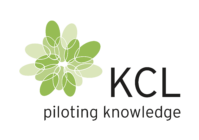The Science Behind Microfibrillated Cellulose
Microfibrillated cellulose (MFC) is a type of nanocellulose derived from plant fibres. It is produced by breaking down cellulose fibres into much smaller fibrils, which are only a few nanometres in diameter. This process results in a material that has a high surface area and unique mechanical properties, making it an attractive option for various applications.
At KCL, we have extensive experience in nanocellulose materials, and our MFC is meticulously designed to meet the requirements of diverse applications. Our MFC is made from industrial agro sidestream, specifically sugar beet pulp, a by-product of the sugar industry. By removing lignin and hemicellulose, and using purely mechanical means, we produce microfibrillated cellulose that is comparable to wood-based analogues. This process is energy-efficient and has a low carbon footprint, making it an eco-friendly material.
The unique properties of MFC, such as its high strength, flexibility, and biodegradability, make it a promising material for sustainable product development. Its ability to form strong hydrogen bonds and its high aspect ratio contribute to its exceptional mechanical properties, which can be leveraged in various industries.
Innovative Applications of MFC in Different Industries
Microfibrillated cellulose has a wide range of applications across different industries, thanks to its versatile properties. In the paper and packaging industry, MFC can be used to increase the strength and stiffness of paper products. This not only enhances the quality of the final product but also allows for substantial savings in material usage during production.
In the coatings industry, MFC can serve as a natural binder in coating formulations, replacing synthetic latexes and other barrier materials. This makes it an excellent choice for creating eco-friendly coatings that are both effective and sustainable. Additionally, MFC can improve the mechanical properties and durability of coatings, making them more resistant to wear and tear.
Other potential applications of MFC include its use in the food industry as a stabiliser and thickener, in the cosmetics industry as a natural ingredient in skincare products, and in the construction industry as a reinforcement material in composites. The versatility of MFC makes it a valuable material for sustainable product development across various sectors.
Environmental Impact of Using MFC
The environmental benefits of using microfibrillated cellulose are significant. As an eco-friendly material, MFC is biodegradable and derived from renewable resources. The production process at KCL is designed to be energy-efficient and to have a low carbon footprint, further enhancing its sustainability credentials.
By using industrial agro sidestreams, such as sugar beet pulp, we are able to create a valuable product from what would otherwise be waste. This not only reduces waste but also contributes to a circular economy, where resources are reused and recycled to minimise environmental impact.
Moreover, the use of MFC in various applications can lead to a reduction in the use of synthetic materials, which are often derived from non-renewable resources and can have a negative impact on the environment. By replacing these materials with MFC, we can create more sustainable products that are better for the planet.
Economic Feasibility of MFC for Manufacturers
One of the key considerations for manufacturers when adopting new materials is economic feasibility. Microfibrillated cellulose offers several economic advantages that make it an attractive option for sustainable product development. The use of MFC can lead to cost savings in material usage, particularly in the paper and packaging industry, where its strength and stiffness properties allow for the production of lighter and more efficient products.
Additionally, the production process for MFC at KCL is designed to be cost-effective. By using industrial agro sidestreams and employing energy-efficient methods, we are able to produce high-quality MFC at a competitive price. This makes it a viable option for manufacturers looking to incorporate sustainable materials into their products without significantly increasing costs.
Furthermore, the growing demand for eco-friendly materials and sustainable products presents an opportunity for manufacturers to differentiate themselves in the market. By adopting MFC, companies can meet consumer demand for sustainable products and gain a competitive edge in their industry.
Conclusion
In conclusion, microfibrillated cellulose is indeed poised to be the next big thing for sustainable product development. Its unique properties, versatile applications, and significant environmental benefits make it a valuable material for various industries. At KCL, we are committed to providing high-quality MFC that meets the needs of our customers while promoting sustainability and reducing environmental impact.
As the demand for eco-friendly materials continues to grow, MFC offers a promising solution for manufacturers looking to create sustainable products. With its economic feasibility and wide range of applications, microfibrillated cellulose is set to play a crucial role in the future of sustainable product development.
